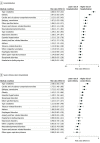Underlying Medical Conditions Associated With Severe COVID-19 Illness Among Children
- PMID: 34097050
- PMCID: PMC8185607
- DOI: 10.1001/jamanetworkopen.2021.11182
Underlying Medical Conditions Associated With Severe COVID-19 Illness Among Children
Abstract
Importance: Information on underlying conditions and severe COVID-19 illness among children is limited.
Objective: To examine the risk of severe COVID-19 illness among children associated with underlying medical conditions and medical complexity.
Design, setting, and participants: This cross-sectional study included patients aged 18 years and younger with International Statistical Classification of Diseases, Tenth Revision, Clinical Modification code U07.1 (COVID-19) or B97.29 (other coronavirus) during an emergency department or inpatient encounter from March 2020 through January 2021. Data were collected from the Premier Healthcare Database Special COVID-19 Release, which included data from more than 800 US hospitals. Multivariable generalized linear models, controlling for patient and hospital characteristics, were used to estimate adjusted risk of severe COVID-19 illness associated with underlying medical conditions and medical complexity.
Exposures: Underlying medical conditions and medical complexity (ie, presence of complex or noncomplex chronic disease).
Main outcomes and measures: Hospitalization and severe illness when hospitalized (ie, combined outcome of intensive care unit admission, invasive mechanical ventilation, or death).
Results: Among 43 465 patients with COVID-19 aged 18 years or younger, the median (interquartile range) age was 12 (4-16) years, 22 943 (52.8%) were female patients, and 12 491 (28.7%) had underlying medical conditions. The most common diagnosed conditions were asthma (4416 [10.2%]), neurodevelopmental disorders (1690 [3.9%]), anxiety and fear-related disorders (1374 [3.2%]), depressive disorders (1209 [2.8%]), and obesity (1071 [2.5%]). The strongest risk factors for hospitalization were type 1 diabetes (adjusted risk ratio [aRR], 4.60; 95% CI, 3.91-5.42) and obesity (aRR, 3.07; 95% CI, 2.66-3.54), and the strongest risk factors for severe COVID-19 illness were type 1 diabetes (aRR, 2.38; 95% CI, 2.06-2.76) and cardiac and circulatory congenital anomalies (aRR, 1.72; 95% CI, 1.48-1.99). Prematurity was a risk factor for severe COVID-19 illness among children younger than 2 years (aRR, 1.83; 95% CI, 1.47-2.29). Chronic and complex chronic disease were risk factors for hospitalization, with aRRs of 2.91 (95% CI, 2.63-3.23) and 7.86 (95% CI, 6.91-8.95), respectively, as well as for severe COVID-19 illness, with aRRs of 1.95 (95% CI, 1.69-2.26) and 2.86 (95% CI, 2.47-3.32), respectively.
Conclusions and relevance: This cross-sectional study found a higher risk of severe COVID-19 illness among children with medical complexity and certain underlying conditions, such as type 1 diabetes, cardiac and circulatory congenital anomalies, and obesity. Health care practitioners could consider the potential need for close observation and cautious clinical management of children with these conditions and COVID-19.
Conflict of interest statement
Figures


Comment in
-
COVID-19 in Children-Not Just Little Adults.JAMA Netw Open. 2021 Jun 1;4(6):e2111441. doi: 10.1001/jamanetworkopen.2021.11441. JAMA Netw Open. 2021. PMID: 34097052 No abstract available.
References
-
- Kim L, Whitaker M, O’Halloran A, et al. ; COVID-NET Surveillance Team . Hospitalization rates and characteristics of children aged <18 years hospitalized with laboratory-confirmed COVID-19—COVID-NET, 14 states, March 1–July 25, 2020. MMWR Morb Mortal Wkly Rep. 2020;69(32):1081-1088. doi:10.15585/mmwr.mm6932e3 - DOI - PMC - PubMed
-
- Shekerdemian LS, Mahmood NR, Wolfe KK, et al. ; International COVID-19 PICU Collaborative . Characteristics and outcomes of children with coronavirus disease 2019 (COVID-19) infection admitted to US and Canadian pediatric intensive care units. JAMA Pediatr. 2020;174(9):868-873. doi:10.1001/jamapediatrics.2020.1948 - DOI - PMC - PubMed

